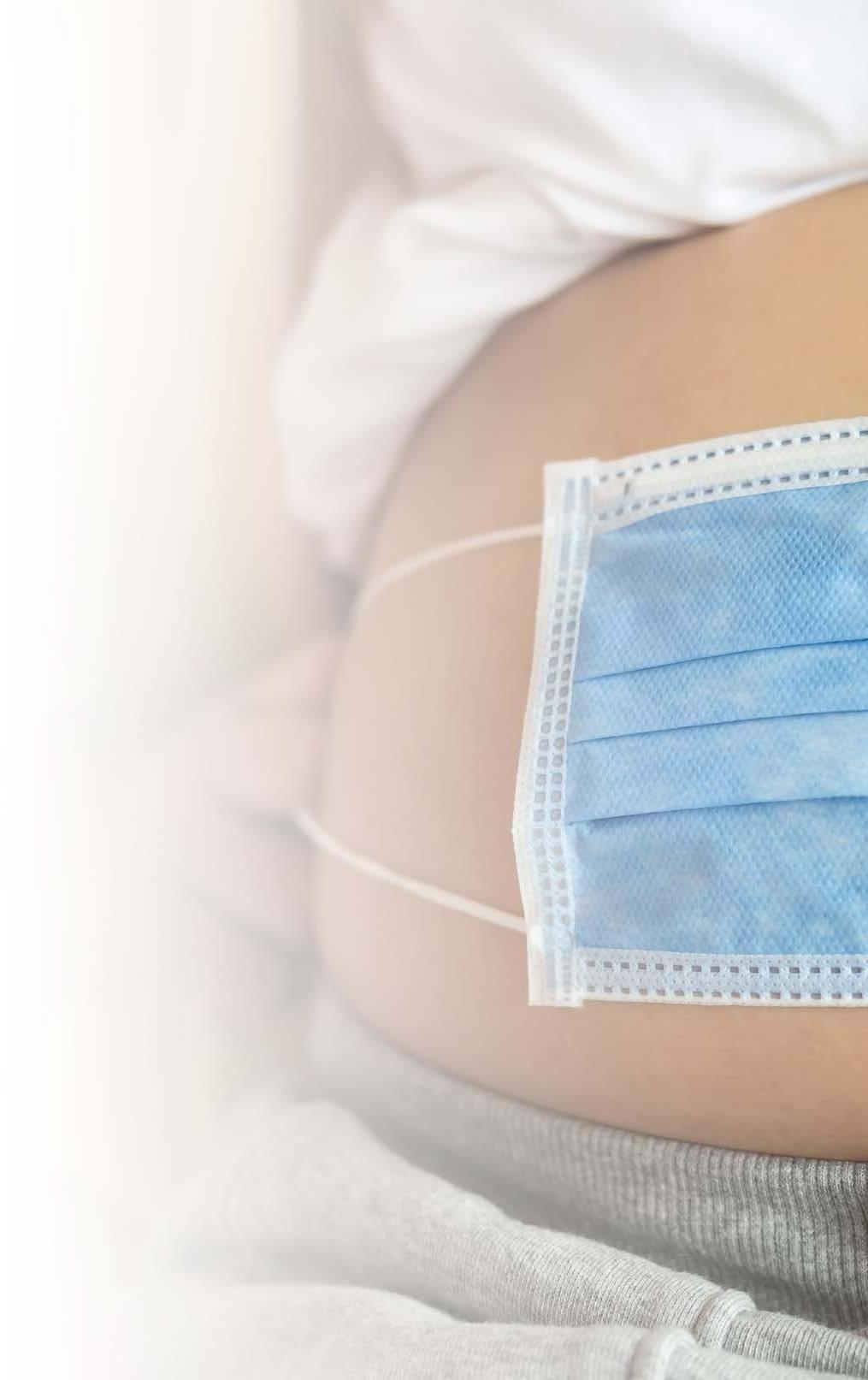
8 minute read
Midwifery Adapts to COVID-19
BY LOUIS PILLA
From increased use of telehealth to alternative birth settings, nurse-midwives are creating optimal birth experiences for their patients during the COVID era.
Midwifery Adapts
COVID’s reach knows no bounds, its tentacles encircling the old, the young, and even the unborn. For nurse-midwives, the pandemic presents unique challenges as they care for their pregnant patients.
Because of COVID-19, nurse-midwives have had to make significant adaptations in caring for women. In this article, we’ll take a closer look at those changes, including the increased use of teleheath, limits to visitors during in-person visits, including labor and delivery, alternative birth settings, and more.
Tapping into Telehealth
Like other providers challenged to provide care during COVID-19, nurse-midwives have dramatically increased the use of telehealth. “Most of our visits are face to face; telehealth was not a huge part of our practice,” says Mary R. Franklin, DNP, MSN, CNM, director of the Nurse Midwifery program and lead
instructor of the Women’s Health Nurse Practitioner program at the Frances Payne Bolton School of Nursing at Case Western Reserve University in Cleveland, Ohio. “Moving to telehealth was a huge change.”
Although patients may have had some uncertainty about a telehealth visit, once they have that first visit, “their lens shifts that it is going to be OK to continue with telehealth, and they feel safer and more protected,” than risking an exposure for themselves, says Jenna LoGiudice, PhD, CNM, RN, FACNM, an associate professor of nursing and program director of the DNP midwifery program at Marion Peckham Egan School of Nursing and Health Studies at Fairfield University in Fairfield, Connecticut. She is also secretary of the Connecticut affiliate of the American College of Nurse-Midwives (ACNM). The biggest change for the patient, says LoGiudice, is not hearing the fetal heartbeat during a telehealth visit.
Recently, noted LoGiudice, the American Journal of Obstetrics & Gynecology MFM published guidelines for midwifery care in the time of which are largely the visits associated with blood draws and ultrasounds, and in the last month of pregnancy.
Midwives at Jefferson Hospital in Jefferson Hills, Pennsylvania, part of Pittsburgh’s Allegheny Health Network, also are making greater use of telehealth. “It’s actually been great,” says Amanda McPherson Shafton, DNP, MSN, CNM, lead midwife at Jefferson and Pennsylvania affiliate president of the ACNM. “Midwifery care is very much about empowering people to take charge of their own health care. And so for me a video visit fits straight in with that.”
Getting to the office for a visit can pose a burden for some patients, Shafton notes. In one instance, she conducted a postpartum visit via been difficult for the patient to fit a postpartum visit into her life.
“With health care today we need to give people options, and this puts more power in the patient’s court,” Shafton says. It’s recognizing that health care should be where “the practitioner is in a partnership with the patients. It’s not that we hold all the knowledge, and they have to come to us to get it. It’s really trusting that a lot of times patients

COVID that detail how to safely deliver care through telehealth. It outlines, she says, which visits the patient should come in for an in-person visit, telehealth for a woman who went into a back room while she was working at a fast food restaurant. Without this telehealth option, it may have know exactly what’s going on with them, and I trust them to call me because nobody’s more invested in their pregnancy, in their baby, than they are.”

Limits on Visitors
Another major change due to COVID-19 is limiting the number of visitors that a woman can have, both during prenatal visits and during labor and delivery. In New York City, notes Franklin, no visitors were allowed to be with women during labor and delivery, causing a great deal of stress. In other parts of the country, one visitor could be allowed. That too, however, was less than optimal, in that the woman might have to choose, for instance, between her doula and her partner. “Minimizing the number of support people was a big change and a real problem,” she says.
The story at Allegheny Health Network is much the same. “We’ve had to limit the number of support people that are able to accompany the birthing person, so we’re only able to have one support person in our network currently,” says Shafton. “A lot of times that ends up being the partner. So for a person who was planning on having a doula or their mom, or whoever it may be, as another support person or persons present during labor that can be a big change for them.”
One creative solution involved having a second person present during labor and delivery electronically, says LoGiudice. For instance, a doula could attend via a system like Apple’s FaceTime.
PPE Adds a Layer
The use of additional personal protective equipment (PPE), while not drastically changing the care midwives provide, makes for a different experience, notes Shafton. “It definitely feels to me harder to emote with people when something really good or really terrible is happening,” she says. For many midwives, particularly those in out-of-hospital settings, additional PPE added another layer of separation, notes Franklin. The patient’s caregivers “were really removed by that personal protective equipment, so that was very stressful for the midwives and their patients.”
Alternatives to Hospital
Concerned about exposure to the coronavirus while in the hospital, women inquired about alternatives such as outof-hospital settings and home births, says Vanessa Daou, DNP, WHNP, CNM, practicing nurse midwife at the Center for Women’s Health and Midwifery in New Haven, Connecticut. The practice is part of the Yale New Haven Health System.
“There was a huge uptick in healthy women seeking out alternative birthing options,” notes LoGiudice. “They don’t want to walk into a hospital where COVID is so strong right
now and risk exposing myself, my partner, my baby.”
One big response was the opening of the Jazz Birth Center of Manhattan, said to be the first and only freestanding birth center in Manhattan. This occurred as the result of an emergency executive order from New York Governor Andrew
providers who support lowintervention birth in a safe setting, she notes. “Whether that is a trained certified midwife at a home, or birth center or hospital, we definitely have had an uptick in interest in midwifery.”
What’s more, in hospitals where both physicians and nurse midwives are delivering infants, there is a tendency for midwifery’s practice to become more of the norm, says LoGiudice. One example: Instead of a two-night stay for a patient who has had an uncomplicated vaginal delivery, there may be openness may extend well beyond the end of the pandemic. “If we can do telehealth on an emergency basis pretty successfully for a lot of people, telehealth might become a bigger part of our practice going forward, because it works,” says Franklin.
“I don’t think any of our health care encounters are going to ever be in the same way that they were before,” says LoGiudice. “COVID has permanently changed the landscape. We may now have more access for people in some ways because we all have had to become experts

Cuomo. In addition, there was in increase in the number of women inquiring about home births, says LoGiudice.
More Interest in Midwives
COVID has also led to an uptick in interest in midwifery, says LoGiudice. Many women are looking for to discharge after one night. “Some things that were inherent to midwifery care, now our colleagues are looking to us for protocols.”
Changed Landscape
Some of the changes nurse midwives and their patients are seeing in the era of COVID-19 in telehealth very quickly. I think we’re going to see improvements in telehealth as we go forward and if anything maybe it’s an opportunity for more access and for people to get access to specialty visits. So hopefully, there’s some positive coming out of all of this.” Some of the changes nurse midwives and their patients are seeing in the era of COVID-19 may extend well beyond the end of the pandemic.
Another plus, according to Franklin, may be encouraging the move toward full practice authority for advanced practitioners. Some states, she notes, have made emergency provisions for advanced practitioners to have full practice authority.
“What we’re all doing and will continue to do is just meet women where they’re at,” says LoGiudice. “Midwives are really good at listening and supporting women. We’re going to really help people to have that birth experience that they’re looking for, even in the midst of all this. So, just because the landscape looks different, doesn’t mean that women are supported any less.”
“I think midwives in particular are born for this, to be honest,” says Shafton. Midwives throughout history have “always been able to navigate through difficult circumstances by relying on our principles of providing really individualized patient-centered care. And that’s all we’re doing; we’re just adapting.”





